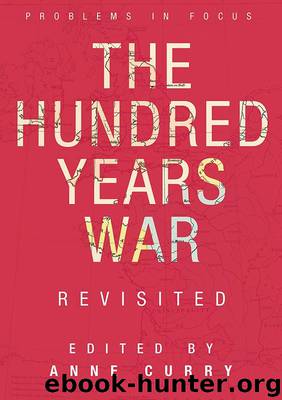The Hundred Years War Revisited by Anne Curry

Author:Anne Curry
Language: eng
Format: epub
Publisher: Macmillan Education UK
THE COUNTRYSIDE AND THE HUNDRED YEARS WAR
English and French towns were threatened, occasionally sacked, during the Hundred Years War but the full brunt of devastation caused by war was borne by the French countryside. This devastation has long been appreci-ated; studies written in France in the 1940s likened the destruction of the Hundred Years War to that which they saw in their own day. Such dramatic descriptions are not limited to twentieth-century observers. Petrarch, writing in 1360, wrote that France was in such chaos that ‘I had to force myself to believe it was the same country I had seen before’. In the next century, Jean Juvénal des Ursins described France as ‘deserted, dissipated, laid waste and broken down’.25 Other records, such as the distribution of papal alms, back up this image of destruction and devastation caused by English chevauchées in particular.26
Despite the miserable picture that emerges, it is important to avoid gener-alisations. Important contrasts can be seen because of the change in English strategy. While the fourteenth-century chevauchées were intended to cause disruption, the fifteenth-century policy was to try to win over the local population to the English cause through order and justice. The Treaty of Troyes confirmed the need to preserve existing French laws and customs. Complaints of violence and insecurity continued, but not all of the soldiers, who were in any case decreasing in number in years of peace, were living off the land and there were repeated efforts to curb those who were. Equally, not all areas were as damaged even in the fourteenth century. Taylor has emphasised how careful Edward III and his sons were not to allow pillaging on the lands of their allies in France.27 Yet, for much of the French rural population in much of the first half of the Hundred Years War, the situation was bleak indeed. Numerous studies have highlighted the value of letters of remission (essentially pardons) for an understanding into the chaos of France in this period, and we have ample other evidence to go on.28
Villages were destroyed; peasants had to pay ransoms to protect themselves. Tales of horrors are all too common, especially under the ‘freebooters’, mercenary soldiers from across Europe who flocked to France to fight on both sides and who, when the kings made peace in 1360, turned into private armies, often called ‘the Great Companies’. How far Froissart’s account of the activities of the captain of one such company, Bascot de Mauléon, can be relied upon is debatable, but the general picture, of thousands of extremely well-trained military men suddenly unemployed setting out to exploit the land for their own gain has been accepted.29 Studies have highlighted the number of young boys taken prisoner, to serve as pages, even as military slaves, in combat as their families could not ransom them, as well as men forced to act as ‘pillagers’ against their own people. For many in the French countryside, there was immense suffering and the images of depopulation, given by Petrarch and Basin, may not be gross exaggerations.
Download
This site does not store any files on its server. We only index and link to content provided by other sites. Please contact the content providers to delete copyright contents if any and email us, we'll remove relevant links or contents immediately.
| Africa | Americas |
| Arctic & Antarctica | Asia |
| Australia & Oceania | Europe |
| Middle East | Russia |
| United States | World |
| Ancient Civilizations | Military |
| Historical Study & Educational Resources |
Elizabeth by Philippa Jones(2181)
Mary Boleyn by Alison Weir(1865)
Traitors of the Tower by Alison Weir(1612)
A Journal of the Plague Year (Oxford World's Classics) by Daniel Defoe(1501)
Notes From a Small Island by Bill Bryson(1365)
Life of Pi by Yann Martel(1308)
A Short History of England by Simon Jenkins(1306)
Queen Isabella by Alison Weir(1288)
Moon Tiger by Penelope Lively(1248)
Eleanor of Aquitaine by Marion Meade(1246)
The Real Middle Earth by Brian Bates(1224)
London Under by Peter Ackroyd(1212)
American Idol by Richard Rushfield(1113)
Tudors Versus Stewarts by Linda Porter(1066)
Her Majesty's Spymaster by Stephen Budiansky(1064)
Albion by Peter Ackroyd(1050)
The Creation of Anne Boleyn by Susan Bordo(1044)
Cromwell, Our Chief Of Men by Fraser Antonia(1011)
Children Of England: The Heirs of King Henry VIII 1547-1558 by Weir Alison(969)
